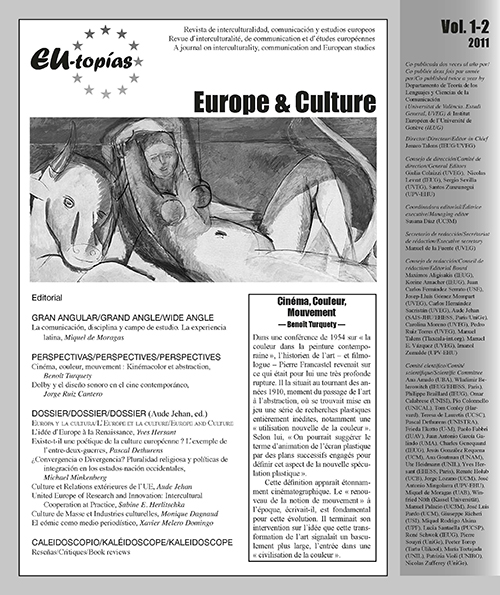Television, the beating heart of the media system
DOI:
https://doi.org/10.7203/eutopias.1.18445Keywords:
Audiovisual, internet, television, cultural exception, mass culture, media, collective imagination, national identity Abstract
Abstract
As regulated public space, television is not a transactional object of thought any more. It has become so embedded in our daily lives that it has also become invisible and is no longer part of the idea debate. However, contrary to what was predicted a few years ago, it has not been overtaken by the Internet, as shown by the average duration of television viewing which continues to grow worldwide.
This article aims to decipher this powerful modern society cog, a «real cultural matrix.» By analyzing the inexhaustible interest in this media, the author underlines its social and identity impact, creating a common collective imagination. Then, she focuses on the specific case of France and its media landscape.
 Downloads
Downloads
 References
References
ACHACHE, Gilles (2010). Le complexe d’Arlequin, Eloge de notre inconstance. Paris : Grasset.
ANDERSON, Benedict (1996). L’imaginaire national: réflexions sur l’origine et l’essor du nationalisme. Paris : La Découverte.
BECKER, Howard S. (1999). Propos sur l’art. Paris : L’Harmattan.
DAGNAUD, Monique (2000). Médias : promouvoir la diversité culturelle. La Documentation française.
DAGNAUD, Monique (2005). “Exception culturelle : une politique peut en cacher une autre”, Le Débat, n° 134, mars-avril.
DAGNAUD, Monique (2006). Les artisans de l’imaginaire, Comment la télévision fabrique la culture de masse. Paris : Armand Colin.
FRODON , Jean-Michel (1998). La projection nationale. Paris : Ed. Odile Jacob. La gazette des scénaristes, Le mal français, n° 20, janvier 2004.
MACÉ, Eric (2006). La société et son double. Paris : Armand Colin.
MAFFESOLI, Michel (2010). Le temps revient, formes élémentaires de la postmodernité. Paris: Ed. Desclée de Brouwer.
NPA Conseil, Etude pour le Festival de fiction de la Rochelle, 2009.
RILEY, John and Mathilda WHITE RILEY. “Choix de programme par les enfants et socialisation”, in Monique DAGNAUD (dir.) (2003). Médias et violence l’état du débat. La documentation Française.
ROUQUETTE, Sébastien (2003). L’impopulaire télévision populaire. Paris: Ed. L’Harmattan.
SCHUDSON, Michael (1994). “La culture et l’intégration des sociétés nationales”. Revue Internationale des Sciences sociales, février.
Société d’études stratégiques pour le cinéma et l’audiovisuel (SESCA), Pour une relance de la fiction française, Étude CSA, novembre 2010.
TARDE, Gabriel, L’opinion et la conversation, revue de Paris, 15 août 1899 et 1er septembre 1899 ; réédité sous le titre de L’opinion et la foule, Paris, 1901.
Downloads
Published
How to Cite
-
Abstract282
-
PDF (Français )59
Issue
Section
License
![]()
The authors conserve the copyright. All content published in EU-topías. Journal of interculturality, Communication, and European Studies are subject to the license Creative Commons Attribution-NonCommercial-ShareAlike 4.0 license. The full text of the license can be found at <http://creativecommons.org/licenses/by-nc-sa/4.0>
They may be copied, used, disseminated, transmitted and publicly displayed, provided that:
- The authorship and original source of the publication is cited (journal, publisher and URL of the work).
- They are not used for commercial purposes.
- The existence and specifications of this license of use are mentioned.
It is the responsibility of the authors to obtain the necessary permissions for images that are subject to copyright.



